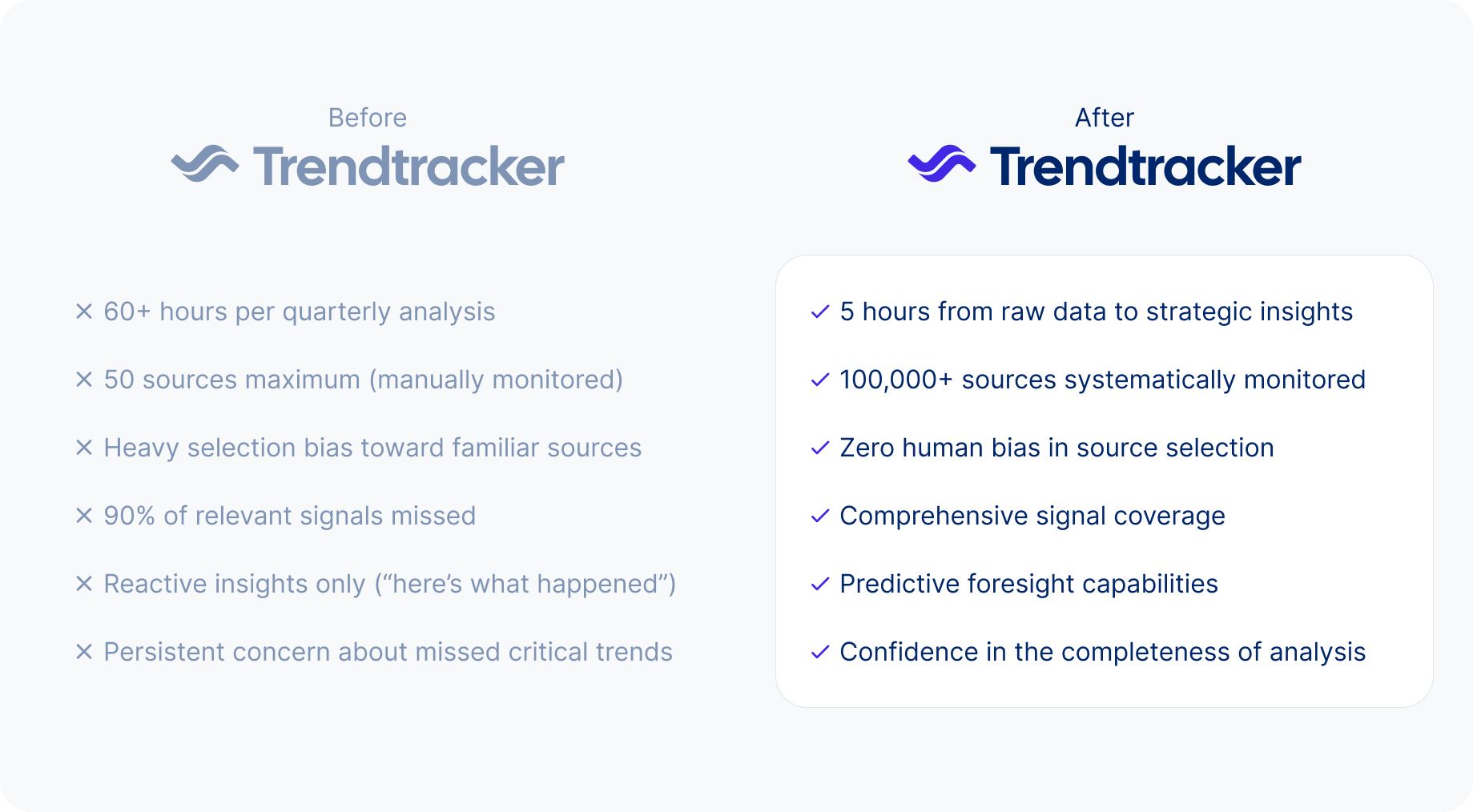How We Solved Every Strategy Consultant's Nightmare
A former strategy consultant's journey from quarterly research challenges to building the AI platform now trusted by PWC, Ageas, European Football Association, and Siemens.

Key takeaways
If you're a strategy consultant, you know exactly what I'm talking about. It's 2 AM, three days before the quarterly strategy presentation. You're surrounded by printouts, browser tabs, and that daunting spreadsheet with 47 different sources you've manually tracked down over the past month.
Your eyes are burning, your coffee has gone cold for the third time, and you have that sinking feeling that you're still missing something important.

The C-suite is expecting comprehensive market intelligence. They want to know what's coming next, not just what happened last quarter. Yet, here you are, frantically trying to synthesize insights from a handful of sources, all the while knowing full well that there are thousands of signals out there that you simply cannot track.
Sound familiar? That was my reality for years as a strategy consultant.
Are you counting the true cost of your research?
When was the last time you critically evaluated the reach of your market intelligence? Here’s the stark reality of modern strategy consulting:
- Sources a human can realistically monitor: 20-50
- Relevant sources that actually exist: 100,000+ per industry context
- Market signals you're missing: ~90%
- Hours spent on data collection vs. analysis: 80% collection, 20% analysis
- Bias in source selection: Inevitable, given the natural tendency to gravitate toward familiar publications.
This isn't sustainable. More importantly, it's not fair to our clients who are paying for comprehensive strategic insights, not educated guesswork based on a limited selection of sources.
When traditional research falls short
For years, like many strategy consultants, I relied on established market research methods. We were good at tracking current trends and analyzing what had already happened.
But I started to notice a recurring problem: we were often missing the "transitions"—those slow, emerging shifts that weren't yet big enough for traditional research to pick up.
These were the quiet signals, often hidden in niche publications, academic papers, or even early online discussions, that could redefine an entire industry later on.
I saw this play out on multiple projects. Small developments, initially dismissed or simply overlooked by our conventional methods, later proved to be very important.. It was evident that our deep expertise was constrained by the limited scope of our data collection. We were reacting to changes after they had gained momentum, rather than anticipating them.
This realization led to the fundamental question that changed everything: "What if we could monitor 100,000+ sources per client and let AI handle the validation and scoring?"
Building a smarter solution with the Trendtracker methodology
We knew we needed a fundamentally different approach to strategic foresight – one that leveraged advanced technology to support strategy consultants in making smart strategic decisions, not only fast, but also unbiased.
That's how we came to develop Trendtracker, an AI-powered strategic intelligence platform designed to provide comprehensive, predictive trend intelligence. But how does this platfrom work?
.png)
Step 1: Global data monitoring - ensuring no signal is missed
Consider for a moment the old way, the manual burden that once defined my daily work:
- Manually bookmark 20-30 "go-to" sources
- Spend hours each week checking for updates
- Inevitably miss emerging sources and niche publications
- Suffering from selection bias toward familiar, English-language, Western sources.
In stark contrast, the Trendtracker way leverages AI to continuously monitor an unparalleled breadth of information.

Our AI monitors 100,000+ sources per client context, including:
- Academic papers (15,000+ journals and repositories)
- Patent databases (25,000+ sources across global patent offices)
- Industry publications (30,000+ sector-specific sources)
- Government reports (10,000+ agencies and departments globally)
- Consumer discussions (20,000+ blogs, forums, social platforms)
- Mass media (15,000+ news outlets worldwide)
The system operates continuously, without favoritism toward any source, and is free from geographic or language bias. Every source gets automatically scored on relevance, credibility, and content quality.
Step 2: AI-powered trend identification - freeing consultants from manual data work
The Old Way:
- Manually read through dozens of articles
- Copy-paste key insights into spreadsheets
- Try to categorize and organize everything
- Spend more time on data organization than actual analysis
When it comes to the Trendtracker way, the Advanced NLP and machine learning do the heavy lifting:

- Document cleaning: Strips out ads, navigation, irrelevant content
- Information extraction: Identifies key concepts, entities, relationships
- Pattern recognition: Detects emerging themes and connections across sources
- Smart categorization: Organizes by industry, geography, impact level, timeframe
The AI processes millions of documents in the time it would take me to read one white paper. And it doesn't get tired or lose focus on page 47.
Step 3: TINTN predictive scoring - delivering actionable foresight
This is where our approach truly differentiates itself. We developed our proprietary Trend Impact Network & Time Navigator (TINTN) model.
The old way with its limited predictive capabilities:
- Tell clients what happened last quarter
- Make predictions based on limited historical data
- Hope the trends identified are actually meaningful and no major signals were overlooked.
And now, the TINTN way:
Our proprietary model doesn't just identify trends – it predicts how they'll evolve:

- Network Analysis: Maps how trends influence and amplify each other
- Historical Pattern Recognition: Identifies evolution patterns across different contexts
- Probabilistic Forecasting: Calculates most likely future scenarios
- ROESI Framework: Generates specific, actionable strategic recommendations
For the first time in my career, I could confidently tell clients not just what was happening, but what was likely to happen next.
→ Download report: How to Calculate the ROI of a Strategic Intelligence Platform
Making 5 hours do the work of 60
With the Trendtracker methodology fully implemented, the operational impact on our strategic intelligence work was profound:

For the first time, I could walk into a strategy meeting knowing I hadn't missed anything important.
The validation: When PwC called
The real validation came when PwC reached out. They'd heard about our methodology through industry networks and wanted to understand how we were achieving such comprehensive trend coverage.
Today, PwC uses Trendtracker alongside other major organizations:
- Ageas for insurance market intelligence
- European Football Association for sports industry trend analysis
- Siemens for industrial technology foresight
These aren't small pilots – these are enterprise deployments for organizations that demand the highest quality strategic intelligence.
What this changes for strategy consulting
I believe we are at a turning point in strategy consulting. The traditional approach, where human analysts manually track a limited number of sources and label it as "comprehensive market research," is becoming obsolete.
Clients are getting smarter. They're asking harder questions. They want to know not just what happened, but what's coming next. They want confidence that their consultants haven't missed critical signals.
The consultants who embrace AI-powered methodologies will deliver dramatically better insights while working more efficiently. Those who stick to manual approaches will find themselves outcompeted by colleagues who can monitor 100x more sources and provide genuine predictive insights.
The bottom line for consultants
If you're still doing quarterly strategy research the old way – manually tracking sources, organizing insights in spreadsheets, hoping you haven't missed anything critical – you're fighting with one hand tied behind your back.
The technology exists today to monitor every relevant source, process millions of documents automatically, and generate predictive insights about trend evolution.
The question isn't whether this technology will transform strategy consulting – it's whether you'll be an early adopter or get left behind.
Having personally experienced both approaches, I can confidently state: there's no going back to the old way.
Once you've experienced comprehensive, unbiased trend monitoring with predictive capabilities, manual research feels like trying to analyze global markets through a keyhole.
→ Download report: How to Buy the Right Strategic Intelligence Platform
The quarterly strategy meeting no longer needs to be a daunting challenge. It can be a moment of confidence, where you know you've captured every relevant signal and can actually help clients prepare for what's coming next.
That's what Trendtracker was built to deliver. The variety of organizations currently using it shows that I wasn't the only consultant seeking to overcome the limitations of manual research and the ongoing risk of overlooking crucial signals.
Want to see how this methodology could transform your own strategy practice? Then reach out to our experts. The companies mentioned above didn't adopt Trendtracker because it was trendy – they adopted it because it delivers the comprehensive, predictive insights that modern strategy consulting demands.




.avif)

